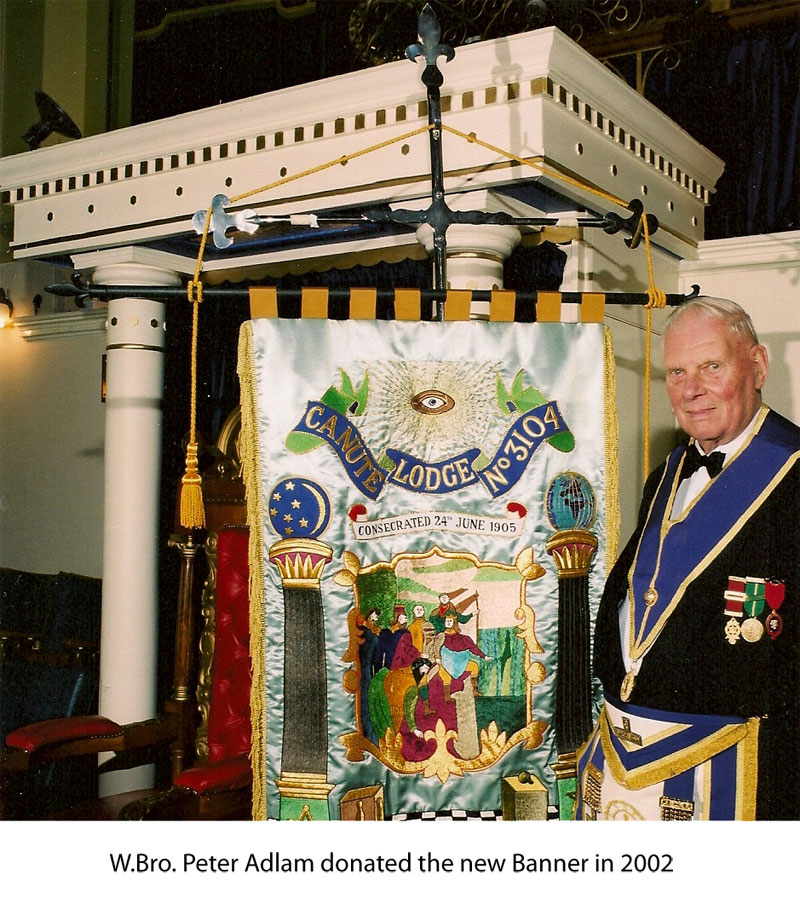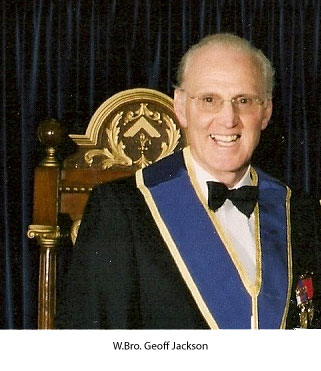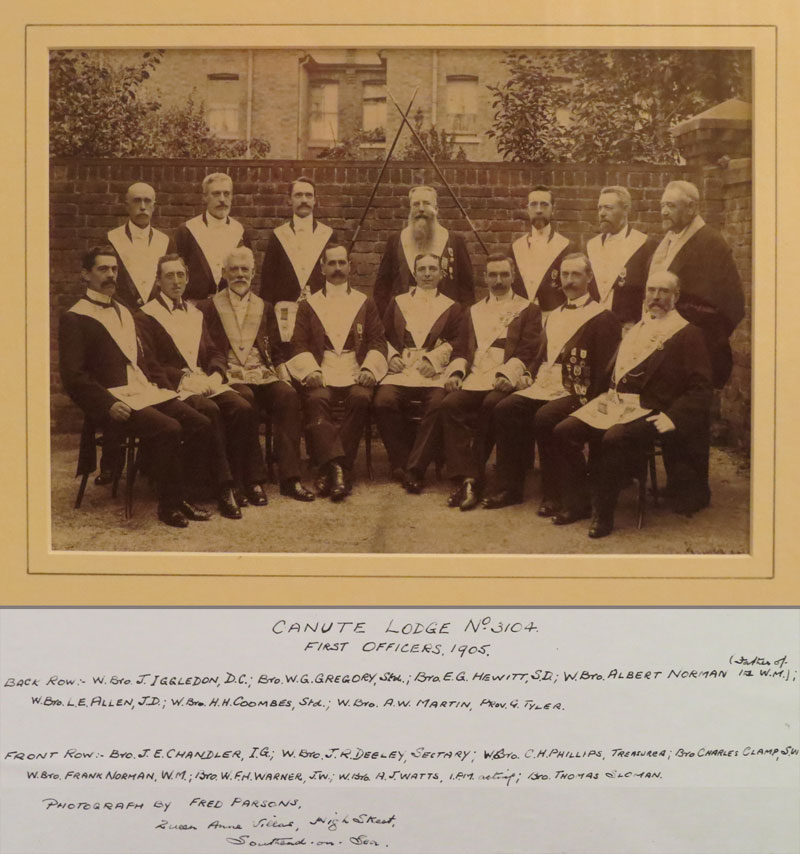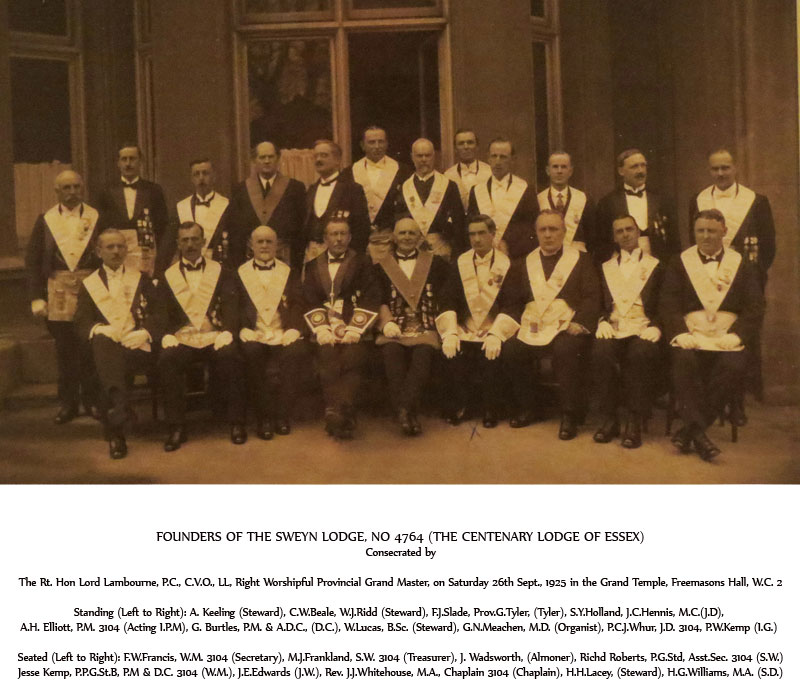The History of Canute Lodge
100 years and 500 meetings ago Canute Lodge was consecrated on 24th June, 1905 by the then Provincial Grand Master, Right Worshipful Brother Colonel Mark Lockwood CVO MP in the presence of 140 enthusiastic masons in the Old Masonic Hall at the Palace Hotel in Southend High Street. It was the 6th to be consecrated in Southend and the 53rd in Essex.
With a growing population of 40,000 there was a strong demand for another Lodge in the town. In a set of bye-laws, little different from any others, Canute specifically defined itself under Bye Law One as a Lodge founded on strict Temperance principles. The Lodge summons had the word “Temperantia” printed across the front page to avoid any doubt.
By way of background it is noteworthy that the British temperance movement had grown very rapidly in the United Kingdom throughout the 1800s, the largest societies numbering thousands of members. Temperance reformers regarded English history as a long series of disasters, all due to drink.
King Sweyn of Denmark was said to have decided to invade England in AD1000 after learning that King Ethelred was a “driveller” wholly given up to wine. The battle of Hastings was said to have been lost because the English spent the night before drinking whereas the Normans devoted it to fasting and prayer.
A contemporary observer even went so far as to say that drunkenness in England had become one of the liberal arts and sciences.
The years of the 19th and early twentieth centuries were characterised by the political battles in society in general, and in Parliament in particular, between the brewers and the Temperance movement, and influential members of society and the aristocracy.
The prevailing climate in local communities after the death of Queen Victoria in 1901 continued to be one of formality. Social life was almost completely confined to the churches, the political clubs and the public houses. At the time of the consecration of Canute Lodge, Southend had become a town notorious for its “gin palaces” and excessive alcoholism, advertising “drunk for 1 penny, dead drunk for tuppence.” This had resulted in Temperance organisations being very active. The Southend Temperance Society had been founded in 1876 and meetings were regularly held on the seafront, off the high street, and in schools.
For these Temperance members there was a very limited choice of venues at which to meet and socialise. The hotelier, William Stubbs, with the support of the proprietor of the local Standard newspaper, John Burrows, conceived the idea of a temperance hotel, and in 1891 opened the Westcliff hotel, which retained its temperance stance until 1923. Other hotels were planned, but did not materialise, apart from the Victoria Temperance Hotel and coffee shop in Alexander Street, which later became the venue for the Canute Lodge of Instruction in 1908. Frustrated at the limited opportunities to meet and socialise, freemasonry was seen as both a sociable and respectable option to pursue.
Hence when the lodge was consecrated the founder members were serious minded representatives of a very significant movement and not some obscure off-shoot of society. It is not wholly surprising therefore that this commitment to temperance prevailed in Canute for more than 50 years under successive masters.
The first master was W. Bro. Francis Albert Norman, a past master of Kensington Lodge 1767. His immediate past master was W. Bro. Watts of St Andrews lodge1817 and his wardens were W. Bro. Charles Clamp of Priory Lodge 1000 and Bro. W F H Warner of Perfect Ashlar Lodge. The generosity and help of these, and other Founders and members, ensured that the lodge functioned impressively from the start. Our first banner was a gift from one of the founders, Josh Francis of Westcliff Lodge.
It was replaced in the 1960s by a hand painted banner by W. Bro. Angus Grant. Our present, lovely Banner, was also gifted to the Lodge by W. Bro. Peter Adlam in 2002.
For the first 50 years, lodge meetings were held in the Palace hotel on Southend seafront. The robing room was a small, cramped, rectangular shaped area, which could barely accommodate the members and guests. The oblong lodge room was again small and sombre with a rumbling dumb-waiter behind the Senior Warden’s chair, the noise of which competed with the solemn music of the organ. The festive board, on ordinary meetings, was held in the red dining room at the back of the hotel. On installation evenings, dining took place in the white room, a much more impressive area overlooking the pier and foreshore. It must have been interesting to observe the contrast of the brethren in their formal attire of white tie and tails, drinking their soft drinks in the reception room, whilst looking out on the mass of sunbathers on the front, beside the entrance to the Pier.
The meals, in those days, seemed to consist of luke warm, brown Windsor soup and rather tough beef, and worthy of little further comment.
During this period, the membership grew rapidly from far and wide, and it is interesting to note that early Lodge summonses contained a timetable for trains on the London to Southend railway line. It was also customary for there to be a restaurant car for the comfort and relief of travellers.
The first joining members comprised a stockbroker, timber merchant, druggist, a gentleman of private means, a hosier [Percy Raven], and John Canon, an engineer on the Central South African Railway living in Kronstad, Orange River valley - obviously our first country member. It was regular practice for the lodge to carry out ceremonies for several candidates at a time, such was the demand.
At the outbreak of the Great War the minutes record the resolution that “so long as the present war lasts, no banquets or suppers were to be held after lodge meetings”.
In reference to the second world war the minutes record that the lodge held a service of thanksgiving on the cessation of hostilities in Europe conducted by the rector of St Andrews, Shoeburyness immediately before the opening of the lodge meeting on Saturday 12th May 1945.
In 1924 the intense pressure on Canute caused by the rapid growth of the lodge to 140 members and a long list waiting their initiation had to be addressed. The answer was to form a new lodge, Sweyn, also on temperance lines. To this time no other temperance lodge has been formed in Southend and Canute and Sweyn lodges have maintained close ties for many years.
By the 1950s the character of Canute Lodge had begun to change. Temperance was declining generally. The Lodge was seen as old-fashioned and there was some discontent among younger brethren looking for innovation and change. The vital issue was to amend bye law one.
In practice it was already being circumvented during two intervals referred to as “comfort breaks” when beer was consumed mainly by visitors and a few members. The prime movers for change were the Master, W. Bro. Sam Pollard and W. Bro. Syd Lennard.
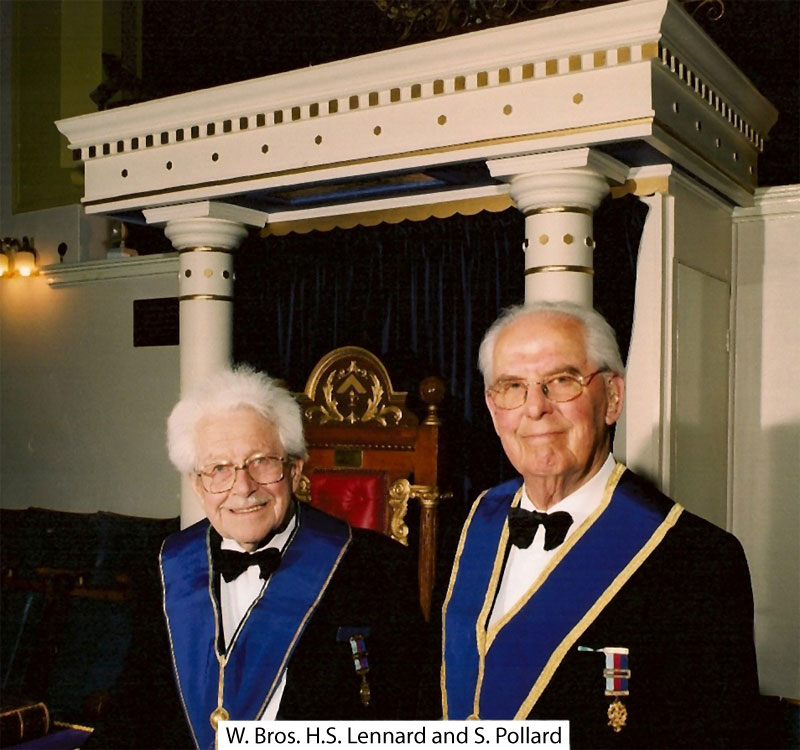
The older past masters were very much against change which required careful negotiation. It took some time for all our members abroad in Canada, Australia and Africa to cast their votes. The overseas members voted to stay tee-total, but the debate and vote in the Lodge produced a big majority in favour of rescinding Bye Law One.
This significant move was implemented in 1964 and it is of great credit to the Lodge that such a sensitive issue was managed with great skill and that not a single member was lost as a result of that decision. The two heroes or villains depending on your point of view are of course here today and I would ask W. Bro. Sam Pollard and W. Bro. Syd Lennard to take a bow.
Although the Lodge meetings were always held at the Palace hotel, Lodges of Instruction were subsequently held in Garons in Southend High Street. The complex at Garons consisted of 3 LOI rooms and a banqueting hall at which ladies nights were invariably held as, coincidentally, the lodge DC was secretary of Garons.
In 1957 the lodge moved to Woodgrange Drive as a Founder of the new centre. The consecration was a very grand affair with music specially written for the occasion by the Canute organist W. Bro. George Lynch and performed by the Canute choir which often sang at special events in the Province.
Sixteen members of the Canute choir were seated on the platform alongside the organ. Canute had brilliant singers in their ranks in those days, especially local greengrocer Gilbert Franks a siver voiced tenor who could have sung professionally, and Bro. Bill Turner who had an exceptional bass voice. The Canute choir was greatly in demand in local communities.
Music came to the fore again in 1973 when some of our members were guests at Prittlewell Lodge’s Old English Night. That visit inspired Canute to develop its own Festive Board Theme. Several of our members had experience of producing Ships’ concerts and with the leadership and enthusiasm of W Bro Angus Grant, a theme based on Vikings emerged. Costumes and horned helmets were made by wives and family. Bro. Jim Bolton and W.Bro. Sam Pollard created a splendid programme of sung toasts with clever lyrics and tunes for the evening which have been constantly adapted through the years, mainly by W. Bro. Allcock, our gifted pianist.
 W.Bro. Don
Allcock
W.Bro. Don
Allcock
Eventually the original Viking theme was succeeded by more flexible themes designed to refresh the formula and to relate to each new master’s hobbies and work interests. These invariably included suitable headware such as fezes, berets, jimmy wigs, stetsons and the use of pantomime horses, camels, mummies etc. The annual crowning of King Canute produced a memorable cameo appropriate to the Master of the year and who could ever forget Alan Freeman’s role as Toulouse Lautrec on our French night. These events have been repeated at each May meeting for 32 years without a break and have been great generators of donations to the Province’s charitable appeals and festivals. By and large we managed to stay on the right side of outrageous.
Coincident with the introduction of Viking Night, W. Bro. Angus Grant together with Bro. Jim Bolton introduced a Lodge newsletter called “The Tide” which included cartoons drawn by W. Bro. John Cackett, letters to the editor, crosswords and articles of Masonic interest. W. Bro. Bob Hyde, an exceptional and dedicated DC later took over as editor and maintained its strength. It was very popular and unusual for its time and a valuable source of material.
The name of W. Bro. Angus Grant crops up regularly in this narrative. He was an innovative and energetic character in every sense, stamping his mark on all aspects of the Lodge. He is remembered for his many contributions but some of us remember him for one particular occurrence in a lodge meeting. Angus had recovered from very serious brain surgery and to the delight of all the members resumed his masonry with vigour. On his return however he insisted as a pharmacist on demonstrating and describing to the assembled lodge members the full gory details of his surgery, whereupon several members fainted and others had to be comforted for several minutes.
And before the men in white coats carry me off let me conclude by confessing that it is not easy to do justice to 100 years of lodge history in a short time or to mention everyone who has contributed to the success of the lodge but not only do we celebrate the support and encouragement given by all members to each other but also the cheerful involvement of wives and family through our many social events. I thank Sam Pollard in particular for drawing on his memories of earlier times which have lent substance to my brief and have highlighted the trends in society which have influenced the character of the lodge over one hundred years.
In the Grand Officer’s address to the brethren it refers to the “grand design of being happy and communicating happiness” and we would like to think that the Canute Lodge of today currently reflects the apotheosis of that principle.
This history of Canute Lodge No 3104 was presented by W.Bro. G.K. Jackson, PPJGW at the Canute Lodge Centenary meeting held at Freemasons Hall, Woodgrange Drive, Southend on Sea on Saturday 25th June, 2005.
